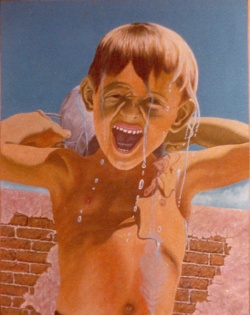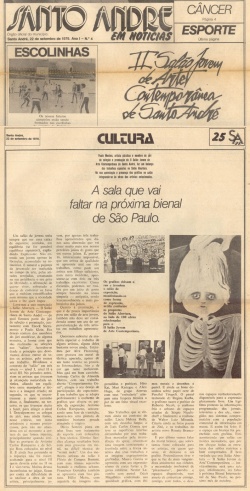Paulo Mentem, artista plástico e membro do júri de seleção e premiação do II Salão Jovem de Arte Contemporânea de Santo André, faz um balanço dos trabalhos expostos no Salão Abertura. Na sua apreciação a presença a presença dos grafites integrando-se
Newspaper Santo André in News Santo André, September 22, 1979. Year 1 - nº 4 - p. 25.
A youth salon would always have to be a box of astonishment, contained, in balance (if it is possible to balance astonishment!), Exploding. I'll explain. I do not understand a young man attached to the formulas, accommodated in the routine. It is natural for the strength of youth to be translated in the field of art, by bold attitudes, dragging in their petulance their cry for freedom, the affirmation of wanting to live, above all the desire to contest the facts that surround them stratified in a system that society adopts and to impose on them.
This opening takes us to the opening of the 11th Young Contemporary Art Salon in Santo André - of which we were part of the selection and award jury, together with Enock Sacramento and Paulo Klein. It was the common desire of the members of the jury to modify, in some way, the way in which selections are made in the salons. It was agreed from the beginning that we should enter all artists, at least one work. We divided the context of the hall into three levels - level 1 - level 2 - level 3.
The first would include artists who had already reached artistic maturity, combining a balance between manipulating the technics and the images created; in the second, those who were halfway there, and finally, in the third those who had a lot to do, to reach level 1. Excuse me, the jury colleagues, but we were still, in this criterion, somewhat orthodox and even pretentious, because the certainty that we were unfair does not abandon me for a single moment, especially when I check the pictures of Antonio Carlos Rampazzo and Sergio Ross placed at level 2. And I still wonder if the injustice was not greater accepting for level 3 who should be in 2 or 1 and vice versa.
Many of these inconsistencies in judging are due to the difficulty of analyzing the work of an artist, mainly young, for only three works presented that give a dimension that will act much more in our precarious judgments of tastes than in other judgments. It is therefore entirely impossible for a quality artist to perform poorly in three works, just as an artist without sufficient breath, in a mere incident, can perform with two or three excellent works. As I said, we can be betrayed by a judgment of taste that is always based on our sympathy - dislike, being irrevocably the poorest of judgments. As for the award, which is of little importance for a young art salon, it should also not be considered as an act of overvaluing three artists in the works presented.
We want to highlight in a special way the work of some artists, some of them quite young. We started with Alex Flemming with a metal engraving with refined technique, although somewhat restricted to the photomechanical process, cold and somewhat inefficient. But he is on track. Antonio Carlos de Almeida Mattos, with his open work “general behavior”, reached his desire for the spectator's participation. It is a work that adapts perfectly to the flood of graffiti that drowned the panels of the exhibition. Antonio Carlos Rampazzo, going through a transition phase, shows us a painting with a very heavy theme, reaching the tragic. Décio soncini paints on thin canvases without treatment of the support with delicacy and good technique. Elenice Sanches achieves good results with her engravings in metal in the difficult technique of “soft varnish”. One of the best artists of the show is Flávio de Campos Bassani, with his great watercolors, focusing on urban realism. Francisco Gonzáles also presents himself with good painting. Hélio Meira with watercolor of detached and poetic images. Hiro Kai, Mari Kanegae and Alice Haga of the Aterras group with their “embalarte”, achieve a technical cleanliness along with an excellent visual feat. These are works that still rise in the context of the show: Lúcia Helena Reily, with a clean design, that of Luis Carlos Gomes, whose internal surfaces were surrounded by her works marked by the irreverence of the spray, creating a contrasting and unusual image between the aseptic coldness of his works and graffiti expressionist images. Mauro Garcia presents himself with an expressionism of strong colors and static figures. Nestor Lacombe with pastel. Odair Magalhães giving its graphic quality with various metals and pastel drawings. And also the good drawings on ocher paper by Percival Tirapeli. The textured pastel by Regina Kutha. Roberto Nicoli's smooth and poetic graphics. The cold and urban realism of spaces created by Sérgio Niculitcheff and finally the realism of Walter Luiz Miranda. I would also quote the photos of Zhô poetry and the works of the new artist Renato Brancatelli.

Alegria de Pobre
And finally, let's talk about the white mural, which we asked to be placed for artists or whoever wanted it, leave your graffiti there. We wanted to take what is most avant-garde in cities today, the irrepressible need for “pixarmurus” (to graffiti), walls and spaces available, in a desire to communicate with me, with you, with everyone in the spaces truly available for fully free expression.
A legitimate protest against the programmed information of newspapers, televisions and so on ... emerged in systems committed to the commercial population and mass information. And so it was done and the blank space was filled with graffiti. A salon is taking place in an innovative way that checks all the structures of the restricted and well-behaved rooms.
It is true that this opening room - II Young Salon of Contemporary Art - will inevitably be a room that, unfortunately, will miss the next São Paulo International Biennial, next October.

